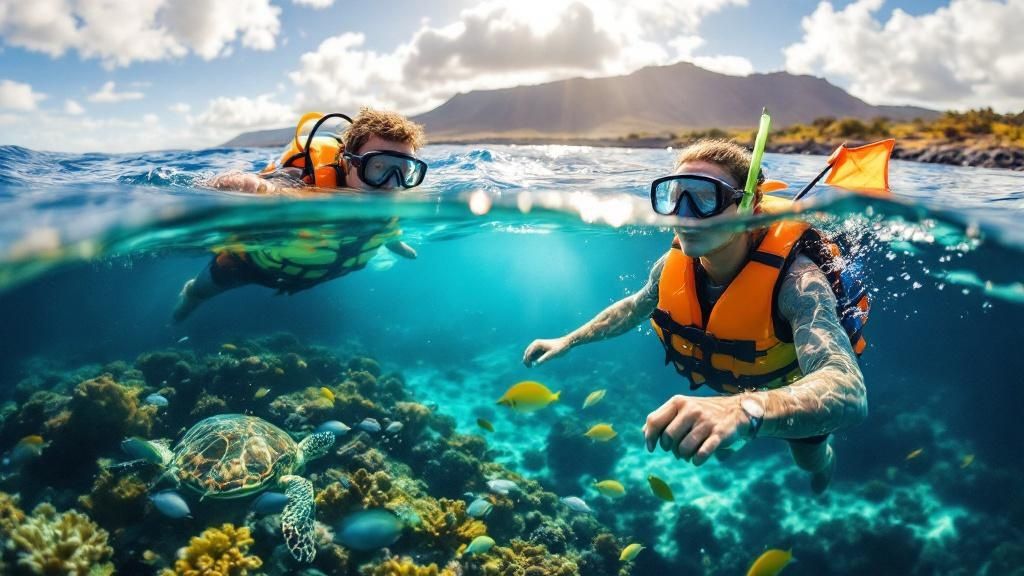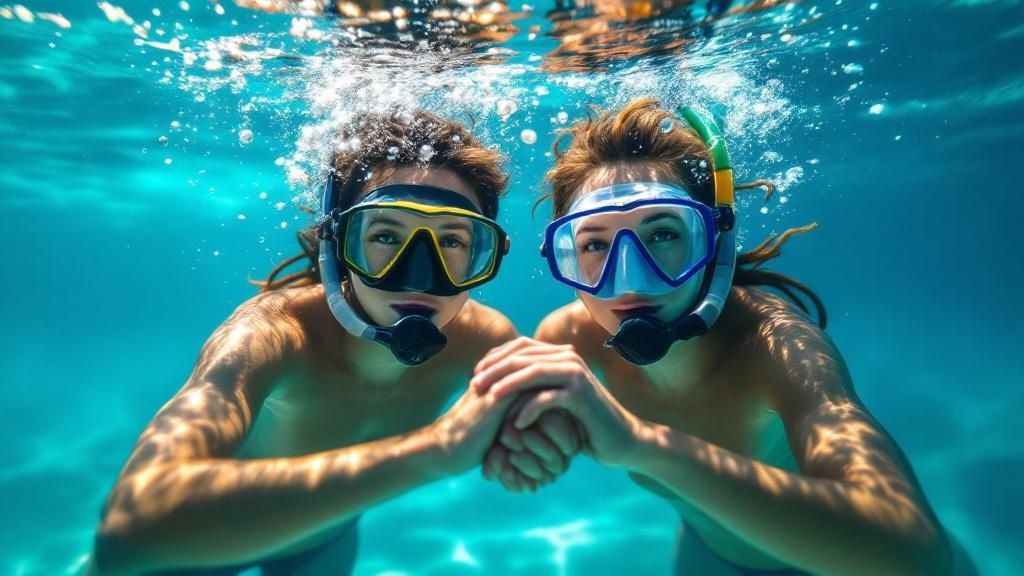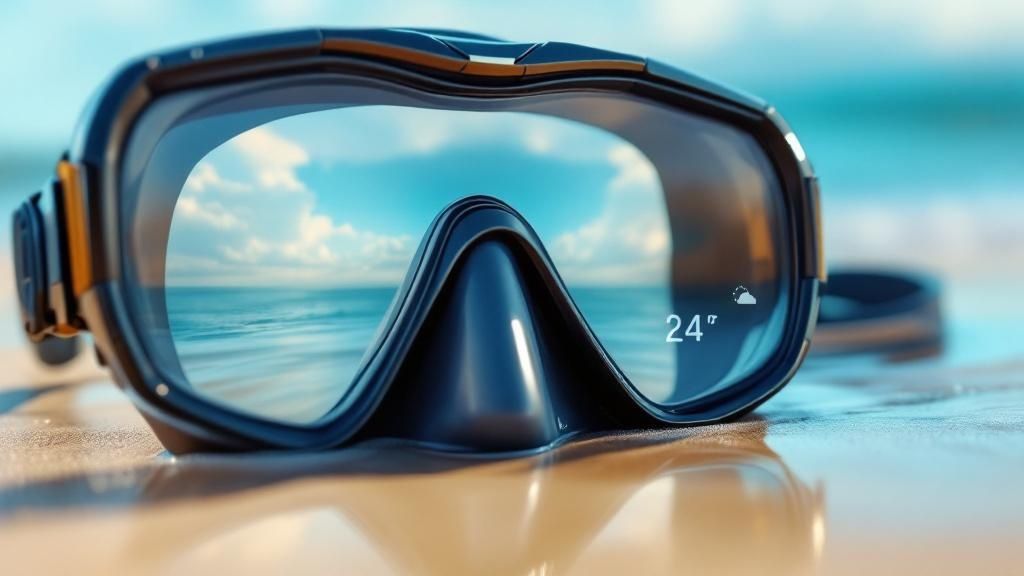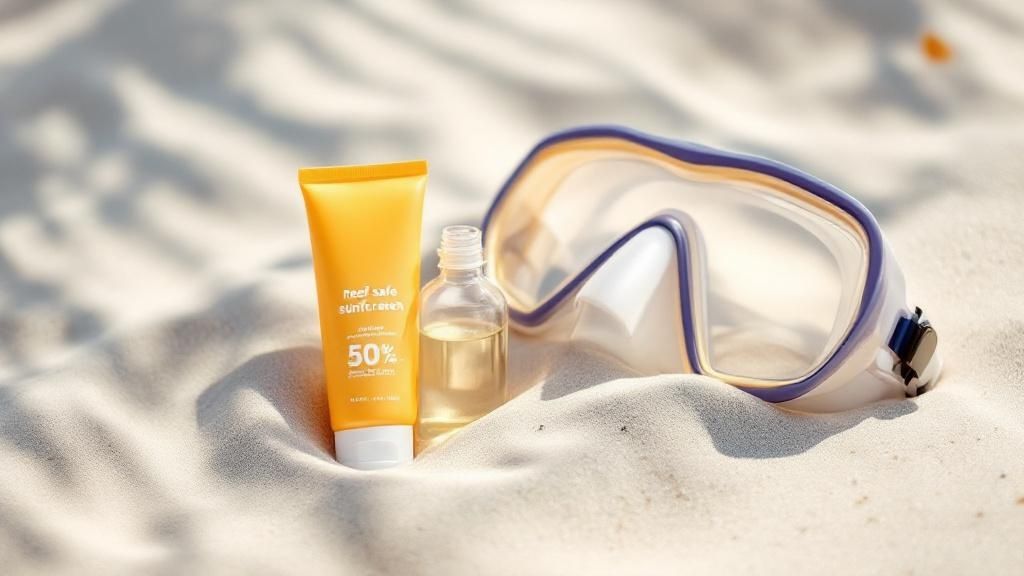8 Essential Snorkeling Safety Tips for 2025

The crystal-clear waters of Kona, Hawaii, offer a breathtaking glimpse into a vibrant underwater world. From the historic Kealakekua Bay to the enchanting Manta Ray night snorkel, every trip with Kona Snorkel Trips promises memories that last a lifetime. To ensure every moment is spent in awe rather than apprehension, understanding and practicing key safety protocols is paramount. This guide is more than just a list; it’s a comprehensive framework designed to empower you with the knowledge our own lifeguard-certified guides use daily.
We'll move beyond the basics, offering actionable insights and real-world scenarios to prepare you for a secure, comfortable, and truly spectacular snorkeling experience. This article provides a deep dive into the most crucial snorkeling safety tips, covering everything from pre-trip equipment checks and understanding ocean conditions to interacting respectfully with marine life. You will learn how to properly use your gear, manage your energy in the water, and what to do if you encounter unexpected situations. By mastering these principles, you'll be equipped to fully appreciate the marine sanctuary of the Kona coast. Let's explore the essential practices that will transform you from a tentative visitor into a confident and safe ocean explorer.
1. Never snorkel alone – Always use the buddy system
The single most important rule in snorkeling is to never venture out alone. The buddy system, a safety protocol adopted from professional diving and military practices, is a non-negotiable component of any safe water excursion. This system requires you to pair up with another snorkeler and remain close to them for the entire duration you are in the water, ensuring someone is always immediately available to provide help.

This simple partnership drastically reduces risk. Should you experience a cramp, feel unwell, or have an issue with your gear like a leaky mask, your buddy is right there to assist. On our Kona Snorkel Trips, we maintain a strict guide-to-guest ratio, but your personal buddy is your first line of defense. This concept is so fundamental that organizations like PADI and SSI mandate it for all their courses.
How to Implement the Buddy System Effectively
To make the buddy system truly effective, it requires more than just swimming near someone. It involves active, conscious cooperation.
- Agree on a Plan: Before you even touch the water, discuss your plan. Decide on a maximum separation distance, typically no more than 6-10 feet, so you are always within easy reach.
- Establish Communication: Simple, non-verbal hand signals are crucial. Agree on signals for "Are you okay?", "Yes, I'm okay," "I have a problem," and "Let's go back."
- Perform Regular Check-ins: Make a habit of looking at your buddy every 30-60 seconds. A quick glance and an "okay" signal confirm that everything is fine.
- Match Skill Levels: Ideally, buddy up with someone who has a similar swimming ability and comfort level in the water. This prevents one person from feeling rushed or left behind.
This 'buddy system' is paramount, and further details on the practice of buddy checks can be found for more advanced water activities like diving. Adhering to this core snorkeling safety tip ensures you and your partner can focus on the incredible marine life with peace of mind.
2. Check weather and water conditions before entering
One of the most critical snorkeling safety tips, second only to the buddy system, is to thoroughly assess environmental conditions before you even think about getting in the water. The ocean is a dynamic environment, and local weather patterns have a direct and immediate impact on water safety, influencing everything from waves and currents to visibility and temperature. A beautiful sunny day on shore does not always guarantee calm, safe snorkeling conditions.

Failing to evaluate the conditions can quickly turn a pleasant outing into a dangerous situation. For instance, the famous winter swells on Hawaii's North Shore create world-class surfing waves but make snorkeling extremely hazardous. Similarly, Caribbean tour operators will wisely cancel trips during tropical storm seasons due to unpredictable currents and poor visibility. On our Kona Snorkel Trips, our captains are experts at reading these signs, choosing sheltered bays when open waters are too rough.
How to Effectively Assess Conditions
Properly checking the conditions involves more than a quick glance at the sky. It requires a multi-faceted approach using reliable data and on-site observation.
- Consult Multiple Sources: Before heading out, check forecasts from reliable marine sources like the National Oceanic and Atmospheric Administration (NOAA) Weather Service. Local news and surf reports can also provide valuable, specific insights.
- Observe On-Site: Once at your location, take time to observe the water from the shore. Look for whitecaps, which indicate strong winds, and note the color and clarity of the water. Murky water significantly reduces visibility and can hide hazards.
- Understand Tides and Currents: Be aware of the local tidal patterns. A changing tide can create strong currents that can easily pull you further from shore than you intended. Ask local experts or lifeguards about known rip currents in the area.
- Prioritize Visibility: Good visibility is key to a safe and enjoyable snorkel. If you can't see the bottom in relatively shallow water from the shore, it’s best to choose another day or a different, more protected location.
This pre-entry check is a non-negotiable step. By respecting the power of the ocean and making informed decisions based on current conditions, you ensure your adventure is remembered for the vibrant marine life, not for an avoidable emergency.
3. Properly fit and test all equipment before use
Well-fitting equipment is the foundation of a comfortable and safe snorkeling experience. A leaky mask, a loose fin, or a poorly positioned snorkel can quickly turn a beautiful underwater tour into a frustrating and potentially dangerous situation. Taking the time to properly fit and test every piece of gear before you venture into deeper water is a critical snorkeling safety tip that prevents common problems like water ingestion, breathing difficulties, and lost mobility.

This proactive approach to equipment readiness is why professional operators like Kona Snorkel Trips conduct mandatory gear checks. Reputable rental shops and resort programs also provide fitting services and orientation sessions. It's a standard practice taught by equipment manufacturers like Cressi and Mares and is a core component of any certified diving course. Properly functioning gear allows you to focus on the marine environment, not on fighting with your equipment.
How to Ensure Your Gear is Ready
Testing your gear is a simple process that pays huge dividends in safety and enjoyment. Follow these steps before every snorkel.
- Test Your Mask's Seal: Place the mask on your face without using the strap. Inhale gently through your nose. If the mask suctions to your face and stays there, you have a good seal. If it falls off, it’s too large or not the right shape for your face.
- Check Fins and Snorkel: Fins should be snug but not so tight that they cut off circulation. Your heel should be fully in the foot pocket. The snorkel's mouthpiece should be comfortable, not causing jaw fatigue.
- Inspect for Wear and Tear: Before each use, quickly check all your equipment for cracks, tears, or signs of significant wear, especially on straps and seals.
- Practice in Shallow Water: Once you think your gear is set, get into waist-deep water. Practice putting your face in the water, breathing through the snorkel, and intentionally flooding and clearing both your mask and snorkel.
Taking these few minutes for a pre-snorkel check ensures you are prepared and confident in your equipment's performance. For a complete guide, explore our overview of the essential gear for snorkeling on the Big Island. This commitment to preparation is a hallmark of a responsible snorkeler.
4. Learn proper breathing techniques and stay calm
Mastering your breathing is fundamental to a safe and enjoyable snorkeling experience. Proper technique ensures a steady oxygen supply, conserves energy, and is your best tool for preventing panic. It involves breathing slowly and deeply through the snorkel tube, managing your rhythm, and knowing how to handle the occasional splash of water without becoming flustered.

Calm, controlled breathing is one of the most vital snorkeling safety tips because it directly impacts your physical and mental state in the water. Panicked, shallow breathing can lead to hyperventilation and a buildup of CO2, causing dizziness and anxiety. Techniques adapted from practices like yoga and freediving focus on diaphragmatic breathing to maximize lung efficiency and promote a state of calm, allowing you to focus on the incredible underwater world.
How to Implement Proper Breathing and Stay Calm
Effective breathing control is a skill that can be learned and practiced. It's about turning an unconscious action into a conscious, deliberate process until it becomes second nature in the water.
- Practice on Land: Before your trip, get comfortable breathing through your snorkel out of the water. This helps you adapt to the sensation without the added pressure of being submerged.
- Breathe Deep and Slow: Avoid short, shallow breaths. Instead, take long, deliberate inhalations and even longer, complete exhalations. This helps balance oxygen and CO2 levels and has a natural calming effect.
- Master the 'Blast Clear': Learn how to expel water from your snorkel with a forceful puff of air, similar to blowing out a candle with force. Practice this so it becomes an automatic reaction if a wave sends water down your tube.
- Focus Your Mind: If you feel a moment of anxiety, pause, float on your back, and focus entirely on your breath. Visualize a calm scene and consciously slow your breathing rate until you feel composed again.
This skill is essential for both safety and enjoyment. You can explore a more detailed guide on how to breathe when snorkeling to build your confidence. By controlling your breath, you control your experience, ensuring it remains a peaceful and awe-inspiring adventure.
5. Maintain awareness of currents and water movement
The ocean is a dynamic environment, and its movements can be powerful and unpredictable. One of the most critical snorkeling safety tips is to understand and constantly monitor water currents. This awareness involves recognizing patterns like rip currents, tidal flows, and nearshore circulation that can easily pull even strong swimmers away from safe areas and lead to exhaustion.
Being current-aware allows you to maintain your position, conserve energy, and avoid being swept into dangerous situations. It is a skill emphasized by organizations like the US Lifesaving Association and is standard practice for professional guides everywhere from the Great Barrier Reef to our own Kona coast. Before entering the water, take a moment to observe the conditions and look for any signs of strong water movement.
How to Stay Safe Around Currents
Properly managing currents requires observation before you enter the water and continuous monitoring while you snorkel. It's about working with the ocean, not fighting against it.
- Identify Rip Currents: Learn the visual signs of a rip current: a channel of choppy, churning water; a noticeable difference in water color; or a line of foam, seaweed, or debris moving steadily away from the shore.
- Use Landmarks: Before you start snorkeling, pick out one or two fixed landmarks on the shore, like a specific tree or rock formation. Glance back at them frequently to gauge if you are drifting and in which direction.
- Plan Your Route: If a gentle current is present, plan your snorkeling trip to begin by swimming against it. This way, the current will help you return to your starting point when you are more tired at the end of your swim.
- Know How to Escape: If you are caught in a rip current, do not panic or swim directly against it. Swim parallel to the shoreline until you are out of the current's pull, then angle back toward the beach.
Developing this awareness is a key snorkeling safety skill that transforms your relationship with the ocean from one of uncertainty to one of respectful confidence. For further training, resources from the National Weather Service's marine forecasts provide valuable information on local water conditions.
6. Apply proper sun protection and stay hydrated
The dual threat of intense sun exposure and dehydration can quickly turn an incredible snorkeling adventure into a miserable and dangerous experience. These two elements are often overlooked because the cooling effect of the water masks the body’s warning signs. However, the water's surface reflects and magnifies UV rays, while the physical exertion of swimming accelerates fluid loss, making sun protection and hydration critical snorkeling safety tips.
Neglecting these precautions can lead to severe sunburn, sunstroke, heat exhaustion, and dangerous levels of dehydration. On our Kona Snorkel Trips, we emphasize this by providing access to fresh water and recommending appropriate sun-protective gear. It's not just about comfort; it's a fundamental aspect of staying safe and healthy while enjoying Hawaii's marine environment, a principle strongly advocated by organizations like the Skin Cancer Foundation.
How to Implement Sun Protection and Hydration Effectively
Properly managing sun exposure and hydration requires a proactive approach, not a reactive one. It starts before you even get on the boat and continues throughout your excursion.
- Choose Reef-Safe Sunscreen: Hawaii's laws mandate the use of reef-safe sunscreens to protect our delicate coral ecosystems. Opt for a mineral-based sunscreen (zinc oxide or titanium dioxide) with an SPF of 30 or higher. Apply it generously 20-30 minutes before sun exposure to allow it to bind to your skin.
- Cover Up with UV Clothing: A long-sleeved rash guard or a full-body skinsuit offers reliable, chemical-free UV protection that doesn't wash off. This is the most effective way to shield your back, shoulders, and arms, which are most exposed while snorkeling.
- Pre-Hydrate and Sip Often: Begin hydrating the day before your trip. On the day of, drink water consistently before, during, and after your snorkel. Don't wait until you feel thirsty; at that point, you are already beginning to dehydrate.
- Reapply and Take Breaks: Sunscreen should be reapplied at least every two hours, and more frequently if you towel off. Taking short breaks in the shade helps your body cool down and provides a perfect opportunity to rehydrate and reapply protection.
Integrating these habits is essential for any water activity. For a more in-depth look, you can review our comprehensive snorkeling UV protection guide. Prioritizing these measures ensures your focus remains on the vibrant underwater world, not on a painful sunburn or a splitting headache.
7. Know your swimming limits and stay within them
One of the most fundamental yet often overlooked snorkeling safety tips is to honestly assess and respect your personal swimming abilities. Overestimating your skills can quickly lead to exhaustion, panic, and potentially dangerous situations, especially in open water. Knowing your limits is not about restriction; it's about making smart choices that ensure your snorkeling experience is enjoyable and safe from start to finish.
This principle involves a candid evaluation of your swimming endurance, your comfort level in open water, and your ability to handle unexpected changes like currents or waves. Many professional tour operators and aquatic safety organizations, like the Red Cross, emphasize this self-awareness as a prerequisite for any water activity. It means choosing snorkeling spots that match your skill level and always keeping enough energy in reserve to return to the boat or shore safely.
How to Stay Within Your Swimming Limits
Effectively managing your physical limits requires a proactive and honest approach to your snorkeling plans. This ensures you never find yourself in a situation that is beyond your control.
- Practice Before You Go: If you're not a regular swimmer, spend time in a pool to gauge your stamina. Practice treading water and floating on your back, as these are crucial low-energy skills for resting in the water.
- Start Small and Shallow: For your first few outings, or if you're feeling uncertain, stick to calm, shallow waters close to shore. This allows you to stand up if needed and builds confidence without significant risk.
- Conserve Your Energy: Snorkel at a relaxed pace. Remember that you need to save at least half of your energy for the swim back. Fighting against a current is exhausting, so plan your route accordingly.
- Take Swimming Lessons: If you feel your skills are not strong enough, consider taking adult swimming lessons. Improving your technique and endurance is the best long-term investment in your water safety.
On our Kona Snorkel Trips, our guides are trained to assess guest comfort levels and keep the group in suitable conditions. Adhering to this crucial snorkeling safety tip means you can focus on the vibrant marine life without pushing yourself into a state of fatigue or anxiety.
8. Be aware of marine life and maintain respectful distance
One of the greatest joys of snorkeling is observing marine animals in their natural habitat, but this privilege comes with a responsibility to be respectful and cautious. Marine life awareness is a critical snorkeling safety tip that involves understanding local species and their behaviors to ensure both your safety and the protection of the fragile underwater ecosystem. This means knowing which creatures to admire from afar and how to behave to avoid stressing the wildlife or provoking a defensive reaction.
Respectful observation not only prevents potential bites or stings but also preserves the natural behaviors of the animals for others to enjoy. On our Kona Snorkel Trips, we are passionate about education and brief all our guests on Hawaii's unique marine residents, like the protected Hawaiian green sea turtles (honu). This knowledge, promoted by organizations like NOAA, is fundamental to a safe and enriching snorkeling experience.
How to Practice Respectful Marine Wildlife Observation
Effective and safe interaction goes beyond just looking. It requires conscious, calm, and informed behavior.
- Learn Before You Go: Before your trip, familiarize yourself with common local marine life. In Kona, this includes understanding the behaviors of moray eels, sea urchins (wana), and various reef fish.
- Maintain Your Distance: A golden rule is to stay at least 10 feet (3 meters) away from most marine life, especially large animals like sea turtles and manta rays. For your safety and theirs, never touch, chase, or corner a marine animal.
- Move Slowly and Predictably: Avoid sudden, jerky movements or loud splashing. Approach areas calmly and slowly to prevent startling animals, which can trigger a flight or defensive response.
- Do Not Feed the Fish: Feeding wildlife disrupts their natural diet, can make them aggressive, and harms the health of the reef ecosystem.
Adhering to these wildlife etiquette guidelines is a cornerstone of responsible tourism. It ensures the animals remain wild and that the beautiful marine environment you came to see is preserved for generations to come. This approach is central to the snorkeling safety tips we practice daily.
Snorkeling Safety Tips Comparison Matrix
| Safety Measure | Implementation Complexity 🔄 | Resource Requirements ⚡ | Expected Outcomes 📊 | Ideal Use Cases 💡 | Key Advantages ⭐ |
|---|---|---|---|---|---|
| Never snorkel alone – Always use the buddy system | Medium – requires coordination and communication | Low – needs a compatible partner | High – immediate emergency help | All snorkeling activities, especially beginners | Instant help, enhanced safety, shared experience |
| Check weather and water conditions before entering | Medium – requires skills interpreting weather | Medium – access to reliable info | High – prevents bad weather risks | Snorkeling in variable weather or new locations | Prevents hazards, optimizes experience |
| Properly fit and test all equipment before use | Medium – time-consuming, requires knowledge | Medium – quality gear and fitting | High – prevents equipment failure | All snorkelers using rented or personal gear | Comfort, safety, reliable gear function |
| Learn proper breathing techniques and stay calm | Medium – practice needed, focus required | Low – no special resources | High – prevents panic, extends duration | Beginners and those prone to anxiety underwater | Improves calmness, energy efficiency |
| Maintain awareness of currents and water movement | High – requires experience and constant vigilance | Low to medium – knowledge based | High – avoids dangerous water situations | Open water snorkeling, coastal areas with currents | Prevents being swept away, improves navigation |
| Apply proper sun protection and stay hydrated | Low – simple preparation and habits | Medium – sunscreen, hydration gear | High – prevents sunburn and dehydration | All outdoor snorkeling activities | Protects skin, prevents heat illnesses |
| Know your swimming limits and stay within them | Medium – requires honest self-assessment | Low – skill management | High – prevents exhaustion and panic | Beginners and recreational snorkelers | Enhances safety, builds confidence |
| Be aware of marine life and maintain respectful distance | Medium – requires education and vigilance | Low – knowledge and precaution | Medium – reduces risky encounters | Areas with diverse or potentially dangerous marine life | Protects snorkeler and wildlife, improves experience |
Embark on Your Next Adventure with Confidence
The vibrant coral gardens and dazzling marine life of Hawaii's coastlines offer an unparalleled glimpse into another world. As we've explored, accessing this underwater paradise safely and responsibly transforms a good snorkeling trip into an extraordinary one. The comprehensive collection of snorkeling safety tips detailed in this guide is not about instilling fear or limiting your exploration; it is about empowerment. Mastering these principles gives you the knowledge and confidence to fully immerse yourself in the magic of the ocean, ensuring every memory you make is a positive one.
From Preparation to Peace of Mind
True confidence in the water begins long before you dip your toes in. It starts with diligent preparation, from checking the local weather and surf reports to meticulously fitting and testing your gear. A mask that seals perfectly and a snorkel that clears easily are your most trusted tools. Once you enter the water, this foundation of preparedness allows you to focus on the more dynamic aspects of safety, such as calm, controlled breathing and maintaining constant awareness of your surroundings.
The most critical snorkeling safety tips revolve around respecting the power of the ocean and understanding your place within it. This includes:
- Honoring the Buddy System: Your snorkel partner is your primary safety net. Consistent check-ins and staying within close proximity are non-negotiable practices.
- Understanding Ocean Dynamics: Recognizing the subtle pull of a current or the changing tide is a skill that keeps you from drifting into hazardous situations.
- Respecting Your Limits: Knowing when you are getting tired and making the conscious decision to head back to the boat or shore is a sign of a smart, experienced snorkeler, not a weak one.
The True Reward of Safe Snorkeling
Ultimately, adhering to these guidelines allows you to shift your focus from worry to wonder. When you are not concerned about a leaking mask, battling a current, or getting too close to delicate coral, you are free to truly appreciate the incredible biodiversity around you. You can marvel at the intricate patterns on a butterflyfish, watch a green sea turtle glide gracefully by, and experience the awe of Kona’s famous manta ray ballet without distraction. Safety is the key that unlocks a deeper, more meaningful connection with the marine environment. It ensures that both you and the delicate ecosystem remain unharmed, preserving its beauty for generations of adventurers to come. These practices are the bedrock of responsible eco-tourism and the hallmark of a truly unforgettable Hawaiian adventure.
Ready to put your knowledge into practice with a team that prioritizes your well-being on every single tour? Our expert guides at Kona Snorkel Trips are dedicated to providing the safest, most spectacular marine encounters on the Big Island. Book your adventure with Kona Snorkel Trips today and explore the underwater world with complete confidence and peace of mind.
